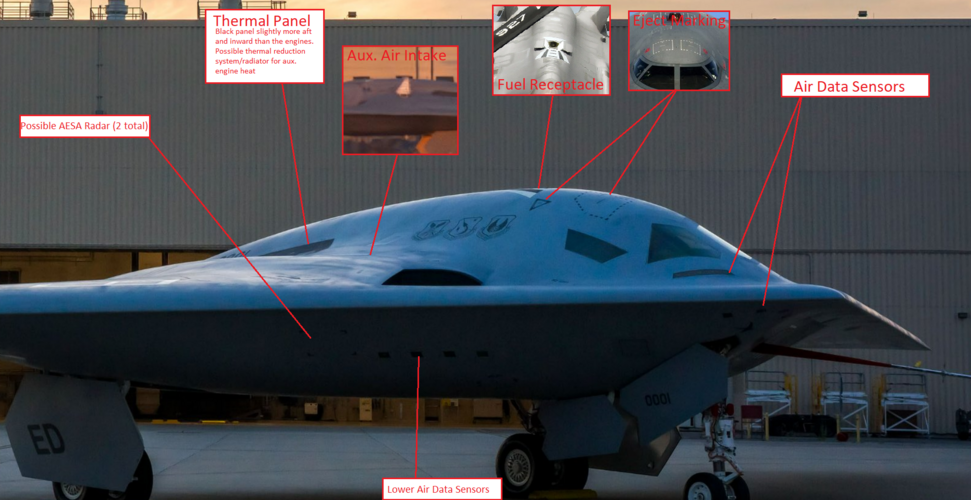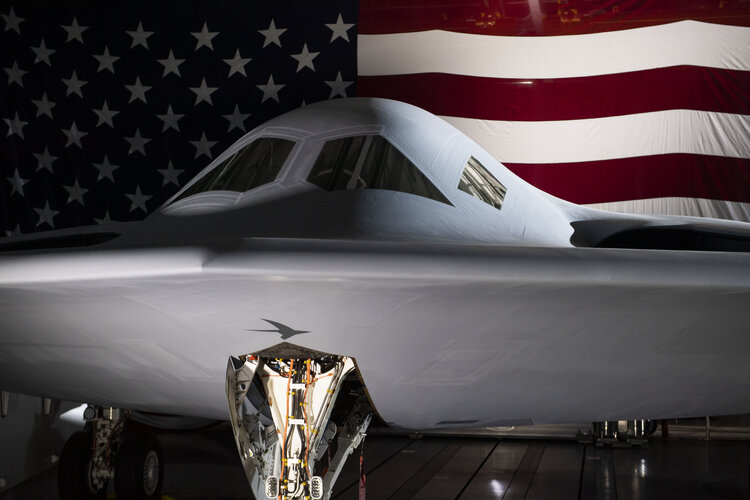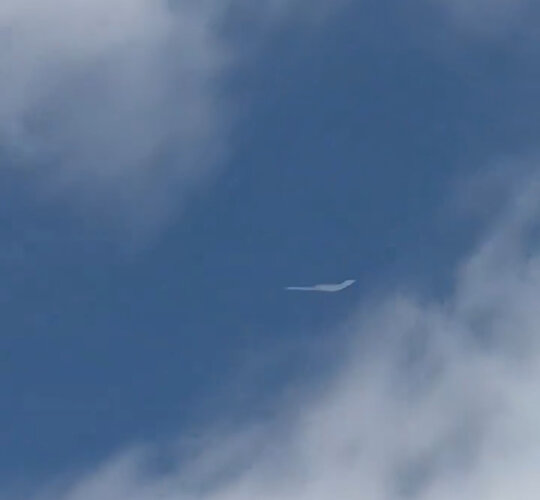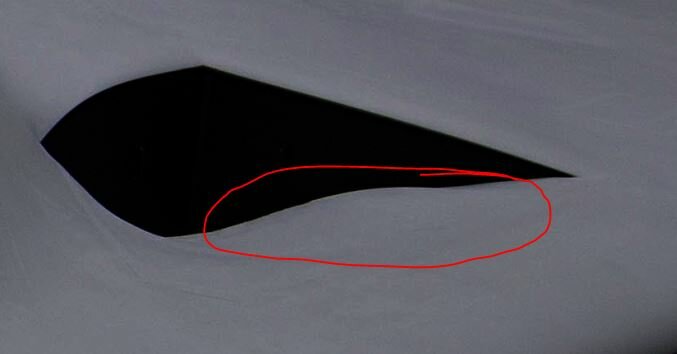When you say "high" cost of living here in CA, remember, marijuana is legal here, Domino's pizza got a high-rate, USG production contract for supplying pizza, LO pizza's of course.What they're doing is moving moving most of their engineering there. If you hire an employee to live in CA, due to the cost of living you have to pay them a lot more. If you hire them to work in FLA, where the cost of living is less, they can pay them less, which means more profits. They'll keep in CA just what they need to operate there.
You are using an out of date browser. It may not display this or other websites correctly.
You should upgrade or use an alternative browser.
You should upgrade or use an alternative browser.
Northrop Grumman B-21A Raider (LRS-B)
- Thread starter TomS
- Start date
Scott Kenny
ACCESS: Above Top Secret
- Joined
- 15 May 2023
- Messages
- 5,995
- Reaction score
- 4,842
Dude, the California cost of living is higher than Snoop Dog or Willie Nelson.When you say "high" cost of living here in CA, remember, marijuana is legal here, Domino's pizza got a high-rate, USG production contract for supplying pizza, LO pizza's of course.
martinbayer
ACCESS: Top Secret
- Joined
- 6 January 2009
- Messages
- 2,374
- Reaction score
- 2,100
Dunno what their precise annual income levels or accumulated wealth assets are, but as a corporate aerospace engineer, I can abide, although I admittedly slum about 20 driving minutes from the Pacific Rim coastline...Dude, the California cost of living is higher than Snoop Dog or Willie Nelson.
- Joined
- 21 April 2009
- Messages
- 13,170
- Reaction score
- 6,056
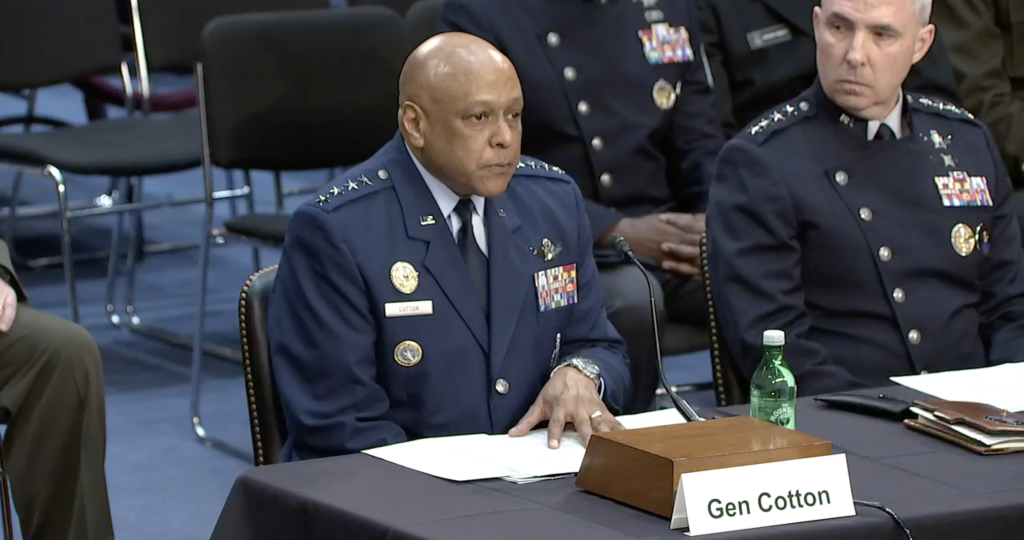
STRATCOM Boss: ‘I Would Love More’ Than 100 B-21s
Gen. Anthony J. Cotton, head of U.S. Strategic Command (STRATCOM) talked about nuclear modernization, particularly the B-21, with lawmakers.
- Joined
- 3 June 2011
- Messages
- 17,332
- Reaction score
- 9,069
MJ may be legal but if you fail a drug test you still get fired.When you say "high" cost of living here in CA, remember, marijuana is legal here, Domino's pizza got a high-rate, USG production contract for supplying pizza, LO pizza's of course.
Probably won't lead anywhere, but something I saw while reading that time article (that I believe that no one has touched on) is the obfuscation of markings on the internal part. Some words remain visible though, so maybe it could mean something.
link to time article: https://time.com/6238168/b-21-raider-bomber-us-military-exclusive/
text below image: zoomed in high-res of image: "Northrop Grumman has opened new hiring and training pipelines as production on the B-21 program picks up.Christopher Payne for TIME | A small portion of this image was removed for security purposes."
(this is part of what we believe to be the intake, likely the front end (?))

link to time article: https://time.com/6238168/b-21-raider-bomber-us-military-exclusive/
text below image: zoomed in high-res of image: "Northrop Grumman has opened new hiring and training pipelines as production on the B-21 program picks up.Christopher Payne for TIME | A small portion of this image was removed for security purposes."
(this is part of what we believe to be the intake, likely the front end (?))
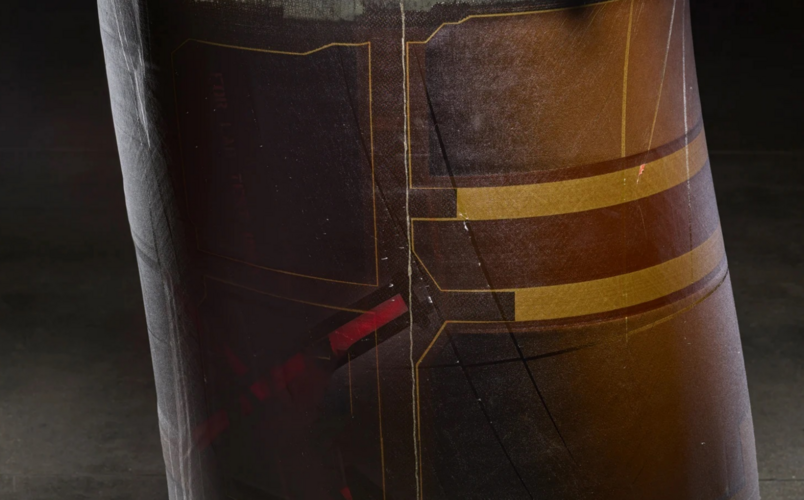
Looks like the red text just says “FOR LAB TEST ONLY”, unless I’m mistaken.
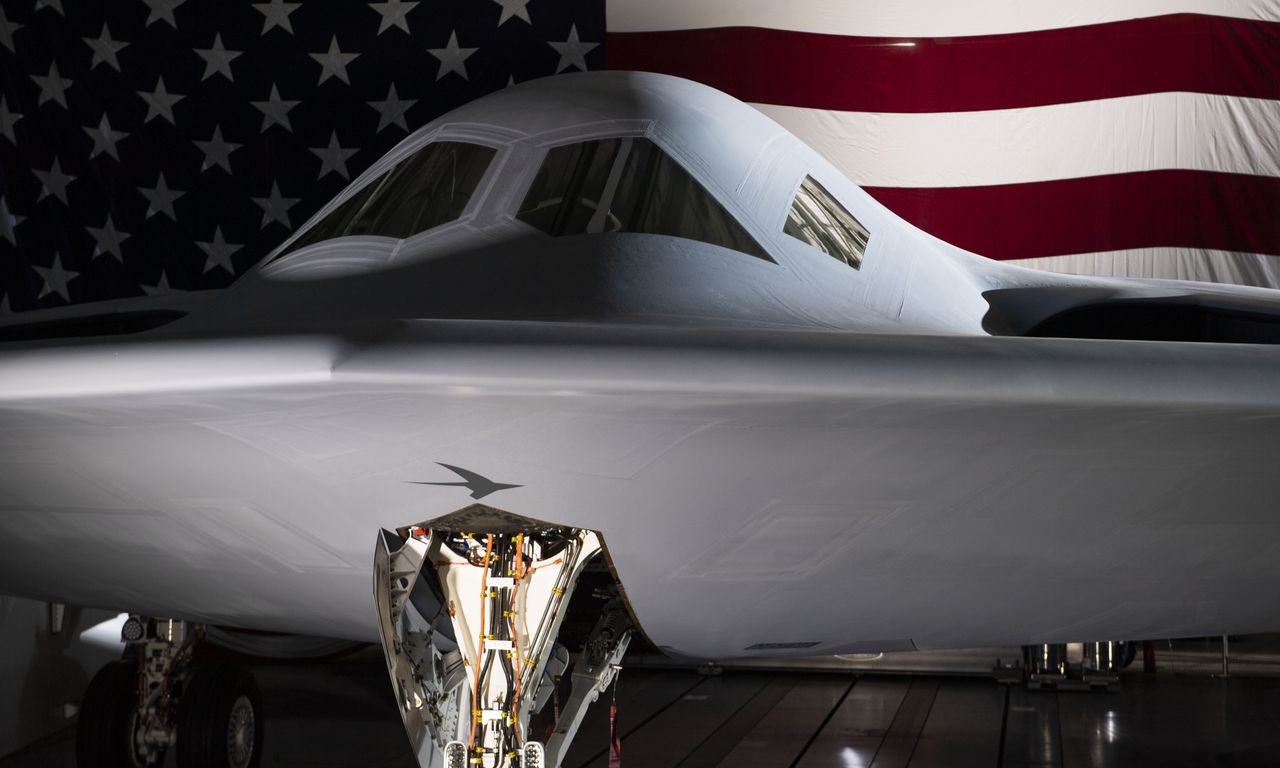
Northrop Grumman’s B-21 Raider Receives Aviation Week Grand Laureate Award
WASHINGTON – March 18, 2024 – Northrop Grumman Corporation (NYSE: NOC) received the Aviation Week Grand Laureate Award in the defense category for its role as the prime contractor delivering the B-21 Raider to the United States Air Force.
Attachments
probably an old picture, considering it is of "Raider 1" (aka the non-flying testbed that was revealed at the ceremony). Never seen another close picture in such high resolution though, and its very interesting looking at how the windscreen is attached,
Northrop Grumman’s B-21 Raider Receives Aviation Week Grand Laureate Award
WASHINGTON – March 18, 2024 – Northrop Grumman Corporation (NYSE: NOC) received the Aviation Week Grand Laureate Award in the defense category for its role as the prime contractor delivering the B-21 Raider to the United States Air Force.news.northropgrumman.com
Last edited:
Forest Green
ACCESS: Above Top Secret
- Joined
- 11 June 2019
- Messages
- 5,093
- Reaction score
- 6,674
Is it not the kevlar jacket for the engine to contain the parts in the event of a major failure?Probably won't lead anywhere, but something I saw while reading that time article (that I believe that no one has touched on) is the obfuscation of markings on the internal part. Some words remain visible though, so maybe it could mean something.
link to time article: https://time.com/6238168/b-21-raider-bomber-us-military-exclusive/
text below image: zoomed in high-res of image: "Northrop Grumman has opened new hiring and training pipelines as production on the B-21 program picks up.Christopher Payne for TIME | A small portion of this image was removed for security purposes."
(this is part of what we believe to be the intake, likely the front end (?))
View attachment 722143
- Joined
- 27 December 2005
- Messages
- 16,454
- Reaction score
- 19,154
Careful shaping of a 'bump' in front of the intake as per F-35 DSI?
Boundary layer ingestion technologies?
Boundary layer ingestion technologies?
- Joined
- 1 April 2006
- Messages
- 10,729
- Reaction score
- 6,754
It's not of courseIs it not the kevlar jacket for the engine to contain the parts in the event of a major failure?
Scott Kenny
ACCESS: Above Top Secret
- Joined
- 15 May 2023
- Messages
- 5,995
- Reaction score
- 4,842
While I haven't seen anything that looks vaguely DSI bump-like, the color of the airframe and the even lighting would make one hard to see in most photos.Careful shaping of a 'bump' in front of the intake as per F-35 DSI?
Boundary layer ingestion technologies?
But I'm still leaning more towards a sieve screen to suck in the boundary layer, like they did on the YF23.
I'd agree with something different than the f35. Wouldn't really be anywhere to put a DSI bump, at least not from the photos taken. Perhaps there is a sieve or some other airflow control system placed within the inlet, behind where the cover sits (which would block it from view in all images).While I haven't seen anything that looks vaguely DSI bump-like, the color of the airframe and the even lighting would make one hard to see in most photos.
But I'm still leaning more towards a sieve screen to suck in the boundary layer, like they did on the YF23.
Attachments
- Joined
- 6 August 2007
- Messages
- 3,011
- Reaction score
- 2,308
B-21 test flight:
Wait, that's not an RQ-180?
Whisperstream
I really should change my personal text
- Joined
- 19 December 2011
- Messages
- 189
- Reaction score
- 315
Was there a chase plane? I only ask because I would expect any B-21 test flight to be accompanied by a safety chase aircraft (usually an F-16). It would be very unusual at this stage of the program not to have one.
- Joined
- 16 January 2015
- Messages
- 710
- Reaction score
- 2,506
Not the easiest thing to see, but there is one (look for the small black speck on the left side of the pic):Was there a chase plane? I only ask because I would expect any B-21 test flight to be accompanied by a safety chase aircraft (usually an F-16). It would be very unusual at this stage of the program not to have one.
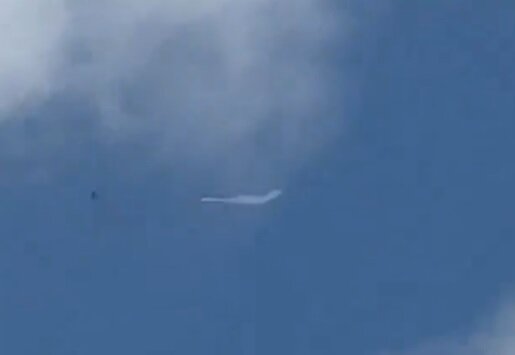
Forest Green
ACCESS: Above Top Secret
- Joined
- 11 June 2019
- Messages
- 5,093
- Reaction score
- 6,674
Almost looks like a ghost. I bet the phone in the FBI X-Files office was ringing off the hook today.
Anybody know why the go fast planes are getting the "chrome job" and B-21 is not?
That coating, whatever it does, does not seem to be operationally used yet. The B-21 also has different performance characteristics and use cases that may make such a coating irrelevant. Or potentially the coating simply isn’t applied to the test article; this is the first flying B-21 and it should not be assumed it is absolutely representative of production machines.
- Joined
- 16 January 2015
- Messages
- 710
- Reaction score
- 2,506
Pet theory of mine is that one is a retrofit (the chromies) while the other ones (B-21 and its cousin possibly) already come with it "skin-deep".Anybody know why the go fast planes are getting the "chrome job" and B-21 is not?
Whatever "it" may be...
- Joined
- 6 August 2007
- Messages
- 3,011
- Reaction score
- 2,308
Anybody know why the go fast planes are getting the "chrome job" and B-21 is not?
Yes.
Definitely an evolved external coating shared by both the B-21 and the "RQ-180", would be interesting if a few B-2s get this coating as well. Definitely can make it difficult to see. Hopefully, we may see more flight test photos. The "chrome/mirror" type coating is probably being evaluated or under consideration with others as well. Have not seen an F-22 or F-35 with a B-21-type coating or I missed it?
As for meaningful additions to this thread, it's quite unfortunate that this specific flight was captured on what might be an iPhone or other camera that lacks a mechanical zoom. Additionally, it's impossible to ascertain how quiet our Raider here is thanks to the fast mover hiding under it, which is even more sad.
Some additional information regarding this raider flight:
View: https://x.com/rubenhofs/status/1776261389348127090
(footage)
View: https://x.com/rubenhofs/status/1776268467441713373
(flight path)
Final edit: it appears the original tweet was deleted. (whoever commented about the FBI x-files guys, you're on the right track)
Some additional information regarding this raider flight:
View: https://x.com/rubenhofs/status/1776261389348127090
(footage)
View: https://x.com/rubenhofs/status/1776268467441713373
(flight path)
Final edit: it appears the original tweet was deleted. (whoever commented about the FBI x-files guys, you're on the right track)
Last edited by a moderator:
- Joined
- 21 January 2015
- Messages
- 10,684
- Reaction score
- 12,344
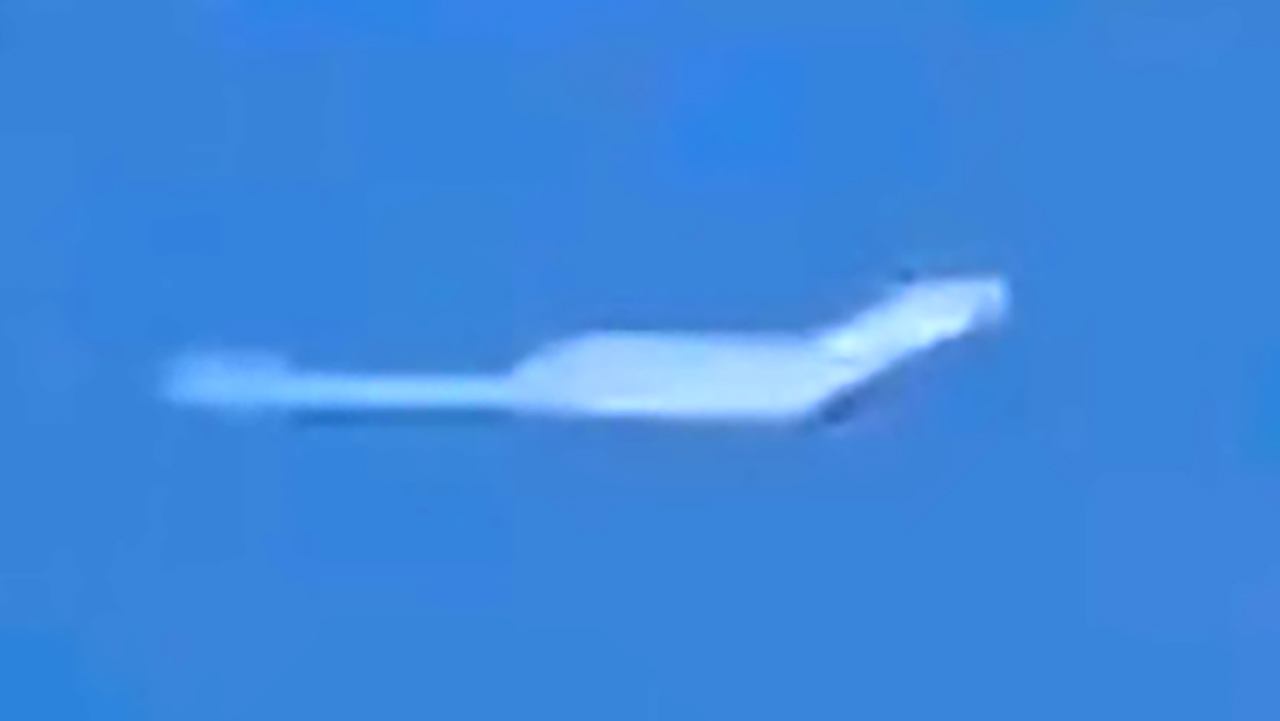
B-21 Raider Spotted During Test Flight
A video appears to show the Northrop Grumman B-21 Raider bomber during a test flight over California. The B-21 Raider is carrying out test flights out of
donnage99
"Robert Gates, is that you??" sublight
- Joined
- 16 June 2008
- Messages
- 1,215
- Reaction score
- 407
In regards to the chrome, notice how the nose section where the radar sits does not get the treatment in regards to the f-22 or f-35. But the f-117 nose section, lacking a radar, gets the treatment.
- Joined
- 6 August 2007
- Messages
- 3,011
- Reaction score
- 2,308
But the f-117 nose section, lacking a radar, gets the treatment.
Those F-117 photos are right up there with the photos, published on the same site, of an RQ-170 in flight refueling
Use caution.
- Joined
- 6 August 2007
- Messages
- 3,011
- Reaction score
- 2,308
US11939078B1 - Active fuel thermal conditioning for aircraft - Google Patents
Fuel used as a coolant in an aircraft can be thermally conditioned for active thermal management of the airframe and engine. The fuel can be thermally conditioned using the residual cooling capacity of a power and thermal module (PTM), providing flexibility of thermal system design, or via a...
patents.google.com
This system is very interesting, and if used on the B-21 it would explain some of the changes/differences between the B-21 and other aircraft when it comes to apertures, cavities, and doors.
- Joined
- 1 April 2006
- Messages
- 10,729
- Reaction score
- 6,754
While I haven't seen anything that looks vaguely DSI bump-like
Attachments
Scott Kenny
ACCESS: Above Top Secret
- Joined
- 15 May 2023
- Messages
- 5,995
- Reaction score
- 4,842
I stand corrected on the no DSI bump, then.
Can you tell us what that "chrome" coating is for, then?I only brought it up because I thought it made for an interesting discussion direction. But I see you mentioned it before. I'm sure you can continue to answer questions any way that you want, it is a freecountryinternet, but at the end of the day it wouldn't hurt if more people liked you. You are going to be publishing stuff on some new platform, and whether you like it or not, it is a popularity contest.
View attachment 724809
View attachment 724811
View attachment 724812
Scott Kenny
ACCESS: Above Top Secret
- Joined
- 15 May 2023
- Messages
- 5,995
- Reaction score
- 4,842
while i assumed a sieve would be used for cooling, perhaps a f35-like bump would work after reading that patent on the fuel cooling system. If they are adequately able to cool exhaust with both fuel cooling and other special systems to dissipate heat, a dsi bump would work far better than a sieve.
Also, recently saw people talking about “active” flow control in the flight control surfaces and had to LOL. Anyone else?
Also, recently saw people talking about “active” flow control in the flight control surfaces and had to LOL. Anyone else?
Similar threads
-
-
USAF to Retire B-1, B-2 in Early 2030s as B-21 Comes On-Line
- Started by flateric
- Replies: 330
-
-
Air Force awards launch vehicle development contracts to Blue Origin, Northrop Grumman, ULA
- Started by Flyaway
- Replies: 8
-

